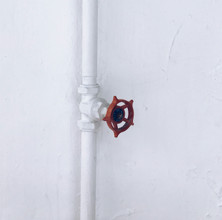How to Tell if a Valve is On or Off
Blog posted by Russ Bailey on Mar 22nd 2024
We have all been there before. You are staring at a valve; you know that you should know if it is off. You are pretty sure—like 99.85% sure— that it's off. But you're not 100%. You don't want to just start turning things to see what happens. What can you do? You can look it up and get that confirmation you are looking for! Maybe you're in a different situation. Maybe you are looking at a valve that you have never used before, like a manually operated butterfly valve. Or perhaps you are dealing with a tricky valve like a non-rising gate or globe valve. Never fear, with a hop, skip, and a jump, we will answer all your questions and send you on your way!
In this blog post, we will explain how to tell if a globe valve, gate valve, ball valve, and butterfly valve are on or off. We will also cover more difficult subjects like how to tell if an actuated valve—meaning a valve with no handle for manual operation—is off or on. We will even explore check valves and pressure reducing valves—which are always "on"—for additional clarification. Now, let's get on with it.
How to Tell if a Ball Valve is Off or On
If you are here staring at a ball valve, wondering if it is off or on, don't worry; your secret is safe with us. Ball valves are very intuitive. When it is off, the handle is perpendicular to the pipe, providing a nice visual representation that it is blocking flow. The valve is on when the handle is parallel with the pipe. This is true for all ball valves, unless something went terribly wrong in manufacturing.
 A ball valve in the off position
A ball valve in the off position
For additional clarification, plastic valves that have a T-looking handle are still ball valves and follow this principle. As a final note, the ball valve handle should point in the direction of flow when it is on. This gives a good visual indication as to which side of the valve still contains water after the valve is shut off.
How to tell if a Gate Valve or Globe Valve is On or Off
Any valve with a handwheel is a bit trickier than a ball valve. First, there is no intuitive indication that the valve is on or off. Second, it is hard to tell if the valve is completely off or on. With these valves, you have to turn them to tell. This means you better know the right direction to turn them otherwise you might make a big mess.
To turn a gate valve off, turn the handwheel clockwise. If you don't spend a lot of time staring at old, analog clocks, you may not think in terms of "clockwise" or "counter-clockwise." Remember that you need to turn the valve to the right. More specifically, turn the handwheel so that the top of the handle moves toward the right. This works regardless of the direction you face the handwheel. To turn a gate valve on, turn the handwheel counter-clockwise, meaning that the top of the handwheel moves toward the left. Once the valve is all the way on or off, the handwheel will no longer turn.
As a final note, a few rare handwheel operated valves do turn in the opposite direction—clockwise to open and counter-clockwise to close—but these are quite rare. However, it is always good practice to check the handle to see if it shows the correct direction to turn.
 A valve with a handwheel. Note that the direction to "shut" the valve is indicated.
A valve with a handwheel. Note that the direction to "shut" the valve is indicated.
Now, most gate valves and globe valves have a rising stem. This means that the handwheel extends further out from the valve body when it is on. It then retracts back down when the valve is turned off. A great example of this is a garden hose spigot. You can look at the stem and try to visually gauge if the valve is on or off. However, this can be quite unreliable and confirming it by hand is a good idea if you need to be sure the valve is on or off.
Some valves with handwheels have non-rising stems. This means that there is no way to tell visually if the valve is on or off and manual confirmation is required. In any case, it is best practice to manually confirm the valve is correctly positioned.
How to Tell if a Butterfly Valve is On or Off
Butterfly valves are intuitive and operate like ball valves, in terms of opening and closing. Even though butterfly valves are far less common and appear in more industrial environments, their operation is simple. The butterfly valve is off when the handle is perpendicular to the pipe. The valve is on when the handle is parallel to the pipe.
Butterfly valves in the on position.
Butterfly valve handles are a bit different than ball valves because they have a latching mechanism. This allows the handle to be positioned somewhere between off and on to regulate flow. Ball valves are generally only used in either the on or off position. The latch on a butterfly valve handle prevents the flow from pushing the valve into the full-open position. As is the case with ball valves, the handle should point in the direction of flow through the pipe.
How to Tell if an Actuated Valve is On or Off
Valves, like butterfly valves, often do not have manual handles. Instead, they have actuators, meaning that an electric or pneumatic force controls the on/off position of the valves. Without valve handles, it is near impossible to visually or manually confirm that a valve is off. Actuated valves are connected to control systems that indicate if the pipes are on or off. The best way to tell if an actuated valve is properly functioning is to install flow meters downstream.

Here is an actuated butterfly valve. This one also has a manual handwheel.
Quite a few actuated valves also have a manual handle as a back-up for emergencies, but these are not adjusted in usual operation. Thus, it is hard to tell, by visual or manual means, if these types of valves are on or off.
Check Valves and the Two PRVs
Sometimes you may come across a valve that looks like its handle broke off, or at least that's what some of these valves look like to me. These are probably either a check valve, a pressure reducing valve or a pressure relief valve. These valves are never really "off." Check valves prevent fluid flowing the wrong direction in a pipe. Thus, they are always "off" to one direction, and always "on" for the other. The only concern with these valves is to ensure they are installed in the right direction. You can confirm this by finding the arrow on the check valve and ensuring that it points in the direction you want the fluid to be able to flow.
Pressure reducing valves, which are the valves right after your water meter, reduce the pressure (shockingly). They are, essentially, a partly open valve and often have a nut at the top of the valve where a handle might go. This nut can be turned to adjust how much pressure is reduced across the valve.
 A pressure reducing valve. © Raimond Spekking / CC BY-SA 4.0
A pressure reducing valve. © Raimond Spekking / CC BY-SA 4.0
A pressure relief valve is valve that is always off, until the pressure in the system reaches a certain threshold. Then, the valve opens. These are safety devices, and the most common example is the safety relief valve on a water heater. These valves—check valves and the two PRVs—don't need to be checked in terms of on or off. They operate automatically and independently.
Recap
Hopefully now you have a handle on how to tell if a valve is on or off. Ball valves and butterfly valves have handles that go with the flow. And gate valves and globe valves turn right until they're water-tight. Here at ValveMan, we have lots of great products and expert information. We cover topics a lot more advanced than this one, and we have a broad range of products for every use. We encourage you to look around on our site and see what you like!
Here are a few recommended articles:




